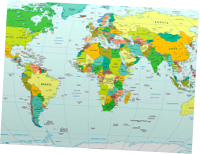

The Evolution of Childbirth
In comparison to other primates, human birth is decidedly more difficult, for a variety of reasons stemming mostly from our skeletons adapted to bipedalism. In their 2003 article, “The Evolution of Human Childbirth” Karen Rosenberg and Wenda Trevathan state that humans are the only primates that routinely seek birth assistance. Why is it that humans often request help with labor and delivery?
From an evolutionary point of view, the development of bipedalism introduced many difficulties into the birth process that other non-human primates do not face. Those difficulties are increased intelligence and brain size relative to body size at birth, as well as a pelvic opening whose size is restricted by our upright posture. Due to this smaller pelvic opening and increased neonate cranial size, the infant human needs to contort and twist in complicated ways, which is often difficult because of limited flexibility of the pelvis (Rosenberg and Trevathan, 2003:82).
As a result, infants born in positions other than the typical occipito-anterior position, such as breech or occipito-posterior can face more difficult births, though percentages of atypical-presentation births are low. Mothers can also experience increased pain, which is more common with occipito-posterior positions, or further complications. However, it is important to remember that all births, even when they deviate from the “norm” can be, and usually are, free from complications.
Also complicating matters is the shape of the average female’s birth canal. In humans, the birth canal is not a uniform shape throughout, which adds to the difficulties faced in human labor and delivery. The human pelvic opening is an average of 13 centimeters in diameter at is largest, and 10 centimeters at its smallest, while an infants head is usually an average of 10 centimeters front to back, and its shoulder 12 centimeters across. The changing dimensions of both the pelvic opening and the infant’s head and shoulders contribute to the difficult maneuvers that must happen for the infant to be safely birthed (Rosenberg and Trevathan, 2003:83).
Rosenberg and Trevathan also indicate that assisted birth is a near-universal human custom as a result of the complications that may occur, while the majority of other primates birth alone. It is estimated that the practices of midwifery and birth assistance may have come about as long as 5 million years ago, with the appearance of a constricted pelvic opening and birth canal. It is also hypothesized that natural selection might have favored the emotions accompanying birth (such as pain, fear, and anxiety) that drive women to seek assistance, as they would result in better outcomes for both mother and child (Rosenberg and Trevathan, 2003:85).
Developed Countries in the West
International Monetary Fund “Advanced Economies”
Austria, Belgium, Canada, Cyprus, Denmark, Finland, France, Germany, Greece, Iceland, Ireland, Italy, Luxembourg, Malta, Netherlands, Norway, Portugal, Slovenia, Spain, Sweden, Switzerland, United Kingdom, United States [Source]

CIA World Factbook “Developed Countries”
Austria, Belgium, Canada, Denmark, Finland, France, Germany, Greece, Iceland, Ireland, Italy, Liechtenstein, Luxembourg, Monaco, Netherlands, Norway, Portugal, San Marino, Spain, Sweden, Switzerland, United Kingdom, United States







